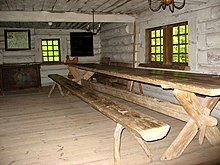




In woodworking, a trestle table is a table consisting of two or three trestle supports, often linked by a stretcher (longitudinal cross-member), over which a board or tabletop is placed.[1] In the Middle Ages, the trestle table was often little more than loose boards over trestle legs for ease of assembly and storage.[2] This simple, collapsible style remained the most common Western form of table until the 16th century, when the basic trestle design gave way to stronger frame-based structures such as gateleg and refectory tables.[3] Ease of assembly and storage has made it the ideal occasional table, and it remains a popular form of dining table, as those seated are not so inconvenienced as they might be with the more usual arrangement of a fixed leg at each corner.
- ^ Webster's Third New International Dictionary
- ^ "Blackburn, G. (n.d.). A Short History of Tables. Retrieved from Fine Woodworking.com".
- ^ Gordon Campbell, The Grove Encyclopedia of Decorative Arts Vol 2, Oxford University Press US (2006) p411